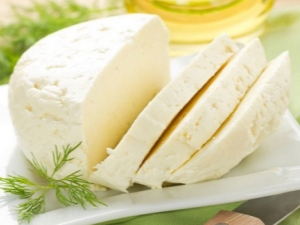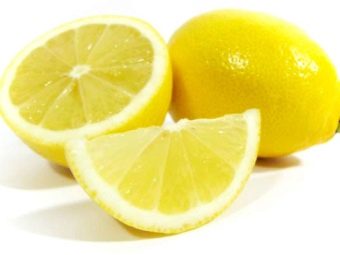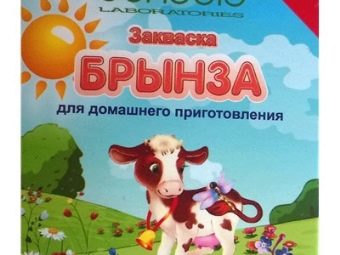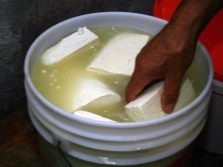How to make cheese from cow's milk at home?

Brynza - pickled cheese, related to soft varieties.The tender, slightly salty taste of Cheese is enjoyed by many, it is ideal both for cooking salads and for self-consumption (especially in the heat).
Despite its relatively high calorie content, the product has a huge variety of nutrients. First of all, it is the predominant in it protein and calcium. Protein promotes the active growth of muscle mass, and calcium - to strengthen bones, hair, nails, etc. In addition, it contains a considerable amount of various minerals that beneficially affect our body.
General principles of cooking
Today, on the shelves of stores you can find cheese from both domestic producers and imported ones. And if for some reason you prefer not to shop cheeses, but to products made by yourself, at home, then the preparation of Cheese will not require much work from you. The main thing is to have on hand milk and salt, as well as some ingredients for the leaven, which is prepared as needed. Moreover, numerous recipes have the same principle of cooking.
So, the main ingredient in the preparation of cheese is milk, so its choice should be approached consciously. To make home-made Cheese really tasty and healthy, it is advisable to use for its preparation natural cow milk. But if there is no such house at hand, then the milk purchased in the store will fit perfectly. It is only important that the percentage of its fat content is at least 3.2. And do not be afraid to buy even a pasteurized skimmed dairy product, because it produces a good low-calorie Cheese.
And one more important moment: from one liter of homemade milk you will get much more soft cheese than from one liter of pasteurized. On this basis, for the preparation of Cheese on commercial milk, it will be necessary to use a larger amount of it. From 1 liter of purchased milk you get a little more than 300 g of finished cheese. While from 1 liter of the home product you can make about 400-450 g. Thus, it does not matter at all what kind of milk we use. It is important that it is fresh.
We bring the already salted milk to a boil, stirring occasionally, then add the starter (vinegar or pepsin) to it, which leads to the fact that it becomes sour. Due to this, under the influence of heat milk is divided into the so-called whey and cottage cheese thick. As soon as the cottage cheese thickens acquire the consistency and appearance of small boiled cottage cheese balls, remove the milk from the stove and throw the resulting mass into a colander, which we cover in several layers with a mesh cloth (gauze). This is necessary in order to qualitatively separate the obtained curd from the liquid, which we decant into any container. It is useful for digestion of brine (the so-called brine), where you can later pickle and save the cooked Cheese.
As a starter, you can use 9% vinegar or freshly squeezed lemon juice, which is always on hand, and you can resort to the use of a special substance, pepsin, developed for leaven and sold in a pharmacy. When working with pepsin, it is very important not to overdo it, because the Cheese will have a peculiar unpleasant sharp-salty taste. In addition, if you overdo it with this substance, then the cheese can become hard, as pepsin has a fast viscosity.
The curd mass separated from the whey is well kneaded, giving shape to the future Brinse. Cooked cheese should have a soft, slightly fragile structure, the color should be white.
Although if you were cooking cheese on 100% cow's milk, unlike a store-cooked product, your Cheese will have a slightly yellowish tint.
The smaller the cheese has holes, the more delicate the resulting taste will be. For this, it is necessary to squeeze the curd mass well, after which, having formed a certain shape, to sustain the resulting lump for several hours under pressure so that excess serum escapes. The time spent under the yoke depends on the quality of kneading. If the mass is not very watery, then five hours will be enough. And if you knead and squeeze badly, then a very watery mass will need to be left under pressure for 10 hours.
Something heavy (stone or metal bar) is ideal for a press or a yoke. But in the absence of it, a heavy container with something is quite suitable (for example, a three-liter jar of jam). Freshly prepared Cheese, leaving in cheesecloth, put in an empty bowl, and put pressure on it, which will allow excess liquid to leave. After a certain time allotted for oppression, you can eat lightly salted cheese.
But in order for Brinza to be better salted and to retain its original taste and color for a longer period of time, it is recommended to store it in specially prepared brine or brine. To prepare it, add water to the already existing whey (one-on-one) and boil a glass of salt in the prepared solution. In such a brine prepared in a simple way, you can preserve the freshness of the cheese for more than 10 days.
If you are not a fan of excessively salty food, then you need to understand that long storage of cheese in a brine will make it taste much more salty. At the same time, brine cannot be stored for a long time without brine. After 3-5 days it starts to dry and turn yellow. It is for this reason that the production volume must be calculated on the basis of not only the storage characteristics, but also its taste preferences.
Recipes
Recipes for cooking cheese, as already noted above, are characterized by the same step-by-step principles. But especially for gourmets and people with restricted food intake, related to their state of health, some corrections were made to the time-tested traditional recipes that made it possible to diversify the well-known taste of traditional Cheese. If you like cheese with a pronounced milky taste and aroma, then you should give preference to goat milk. If cheese is used by you mainly in salads and you do not need rich milky aroma, then cow's milk is required for this.
Traditional recipes are considered to be based on sourdough, according to which Brynza is obtained naturally salty in taste. Earlier it was noted that some use vinegar or citric acid, juice, and others - pepsin as a starter. So what is the difference?
Vinegar cheese is considered a classic, since this substance will not add to the future cheese an additional shade of taste or flavor. And Pepsy Cheese has a sharp-salty taste and a specific bitter flavor. Pepsin, unlike vinegar, combines with milk after boiling (approximately 10 milligrams of enzyme for 2-2.5 liters of milk). Milk with pepsin dissolved in it should be stirred with a whisk until it starts to harden. Further instruction does not deviate from the traditional recipe.
But especially for lovers of soft salty cheese, which are contraindicated products with a high salt content, a recipe with sour cream was developed that does not require soaking in over-salted brine.
- According to this recipe, a small amount of salt is mixed with milk before boiling (two tablespoons of salt with a slide for 2 liters of milk), then 400 grams of 20% sour cream, whipped with five eggs, plays the role of a thickener, due to which the milk begins to sour.
- Subsequent actions do not deviate from the traditional recipe: we recline in a colander, form the head of the cheese, put it under pressure and send it to the fridge for 12 hours. The cheese is ready.
In continuation of the topic of contraindications, it would be useful to note that in the piggy bank of modern hostesses there is a recipe for preparing dietary cheese on kefir, the essence of which is that milk is mixed with kefir at the rate of one to one. Due to this, the fat content of milk is reduced, and as a result, the Brynza cheese is less caloric. The calorie content of dietary cheese per 100 grams of the product is 160 kcal, and in 100 grams of cheese the home milk will contain about 260 kcal.
If you are a lover of savory flavors, then, following the traditional recipe of production, you can cook Cheese, for example, with greens, pepper and other spices.
- To do this, add your chosen spice in the milk before it boils. Additional ingredients, boiling in milk, will give him all their flavor, and then everything is as usual: recline on a colander, put under pressure, etc.
- It is possible to cook Cheese with mushrooms, and with olives, and with bell pepper.
But here you need to understand that raw mushrooms, for example, cook much longer than milk. For this reason, they must first be boiled before being submerged in milk. Otherwise, the under-cooked additional ingredients will begin to deteriorate, which will lead to the speedy unsuitability of the Cheese itself.
How to store?
It does not matter what kind of Cheese you have cooked - with or without additives. Both that and other variant will keep freshness longer, being in a refrigerator, in a rap. Home-made Cheese is allowed to be stored in the refrigerator for up to fifteen days. However, it must be remembered that lightly salted brine will make the cheese soft and poorly shaped. If the solution is too salty, then after 2 days your Cheese will be too salty.
Therefore, In order to keep the taste of fresh Cheese as long as possible, it is very important to maintain the correct proportions of salt in the solution. To do this, we use carefully washed raw chicken egg. If, after adding salt, it floats up, the brine is ready. If not, add salt until it emerges.
It so happens that cheese cooked in excess does not always manage to eat on time. So that he does not disappear, you can send it to storage in the freezer. But remember that after defrosting the structure of the cheese will be slightly watery, poorly preserving shape. And most likely, it will be suitable only for making salads.
In order to avoid the processes of oxidation, cheese in brine is stored in glass, enamel or plastic containers, tightly closed with a lid.
Useful recommendations
In cooking, it is always the case that something is not going according to plan, so we will introduce you to a few helpful tips from experienced housewives, allow to correct some of the shortcomings of cooking.
- If for some reason you cannot keep Cheese in brine, and without it, the cheese dries quickly, becoming covered with an unsightly crust, then you can sprinkle the finished product from all sides with salt and keep it in the refrigerator for up to five days in a tightly closed container.
- It so happens that the cheese turned out to be salty at the stage of digestion, and after all, it is still to be stored in salted brine. Soaking cheese in fresh milk will help to make the cheese less salty (from 2 to 5 hours).
- If you already perederzhat already cooked curd mass on the fire, Cheese as a result will be tough. For this reason, the milk during cooking should be constantly stirring. It is better not to boil over than to digest. We keep the undercooked curd mass in a warm saucepan on the stove for about 30 minutes, during which time it will acquire the desired consistency.
- To make Brynza not sour, it is better to leave it in a refrigerator under a press.
For cooking and storage, it is better to use enamel or glassware, which should be high enough so that when stirring the milk does not spill out.
Thus, a properly selected method of cooking Cheese in the home will allow it to be eaten even by those who have contraindications for health reasons. Allergy sufferers, for example, may not suit the various flavors and preservatives contained in store products. People who are on a diet will be contraindicated with Cheese, made from sufficiently high-calorie home-made milk. Persons with renal insufficiency may be contraindicated for especially salty Cheese, which has been stored for a long time in its own brine.
For information on how to make Cheese from cow's milk at home, see the following video.









































